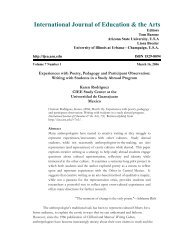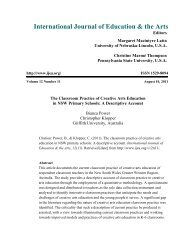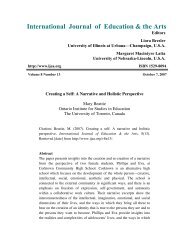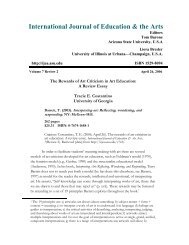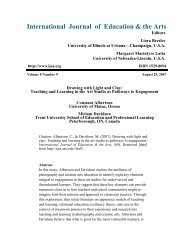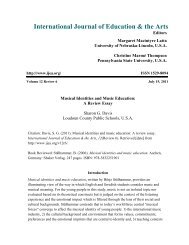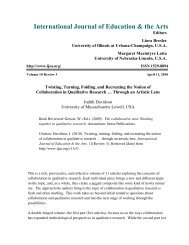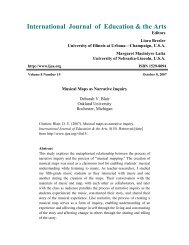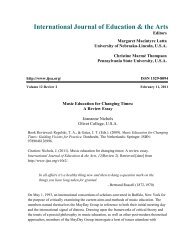On Empathy: The Mirror Neuron System and Art Education
On Empathy: The Mirror Neuron System and Art Education
On Empathy: The Mirror Neuron System and Art Education
Create successful ePaper yourself
Turn your PDF publications into a flip-book with our unique Google optimized e-Paper software.
IJEA Vol. 10 No. 15 - http://www.ijea.org/v10n15/ 6<br />
induce a motor simulation in viewers interacting with works of art (Freedberg & Gallese,<br />
2007, p. 6).<br />
Indeed, Freedberg <strong>and</strong> Gallese (2007) predict that future studies using art works as “stimuli”<br />
will confirm activation of the mirroring mechanism in the motor region (p. 6). Jackson<br />
Pollock’s action paintings are obvious c<strong>and</strong>idates, likely to induce motor simulations of the<br />
abstract expressionist’s “gestural traces.” Less obvious, perhaps, but no less likely to evoke a<br />
motor response is the still life. As Freedberg <strong>and</strong> Gallese (2007) point out, “a still life can be<br />
‘animated’ by the embodied simulation it evokes in the observer’s brain” (p. 5). Simply put, a<br />
“still life is not so still…[it] is really a moving life” (Gallese, 2006). Whereas objects of art<br />
may or may not be experienced as emotionally “moving,” they always evoke “moving”<br />
experiences, neurologically speaking. Moving art in any sense is experienced in <strong>and</strong> through<br />
the resonant body, constituting the kind of aesthetic-empathic experience that, interestingly<br />
enough, Vischer first described more than a century ago.<br />
<strong>The</strong> World of Others<br />
Navigating the world of others requires empathic underst<strong>and</strong>ing of the self, as well as of the<br />
other, <strong>and</strong> an ongoing negotiation of the intersubjective relationship between the two. In<br />
Western culture, the self-other relationship has been variously characterized, as myriads of<br />
philosophers, psychologists, <strong>and</strong> cognitive neuroscientists were challenged to resolve the<br />
perennial problem of intersubjectivity: If a human being (self) has direct access only to the<br />
private entity of his/her own mind, then how is it possible to access the mind of another? How<br />
can the world be shared meaningfully between minds? What is the possibility of empathy?<br />
In some resolutions, intersubjectivity is conceptualized as a binary relationship, a Platonist or<br />
Cartesian self-other duality that, according to the psychologist, Carol Gilligan (1982/93),<br />
results in a “conflict” between responsibilities to the self <strong>and</strong> responsibilities to the other. In<br />
another resolution, self <strong>and</strong> other are envisioned as two sides of the same coin, describing an<br />
interdependent relationship between them (Iacoboni, 2008). Dualistic <strong>and</strong> interdependent<br />
proposals are consequential, as each defines the self <strong>and</strong> other, <strong>and</strong> the nature of their<br />
encounters. Gilligan (1982/93) posits, for example, that when responsibilities to others are<br />
accepted, the self is defined in context of the activities that bring it into connection with<br />
others. This self measures the worth of these activities against an “ethic of care” (pp. 34-35).<br />
Exp<strong>and</strong>ing on the ethical <strong>and</strong> moral dimensions of caring, the educational researcher <strong>and</strong><br />
philosopher, Nel Noddings (1984) describes this self as one who is prepared to receive the<br />
other. This kind of self, according to Gilligan (1982/93), tends to locate its being in relation to<br />
the world. When, on the other h<strong>and</strong>, responsibilities to the self are placed above those to<br />
others, this self is defined in separation from others. <strong>The</strong> isolated self assesses its worth




